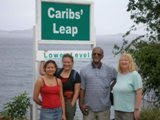
Just a little note to wish you all the very best for the holidays - see you next year!
Best,
Karenne
Most visited postings:
CNN student news
Personally, speaking
BESIG conference
Politics, power and the media
Toys for teachers
Company secrets

 My student Markus called in the early afternoon.
My student Markus called in the early afternoon.
 It sure was murder looking out at the beautiful Grenadian sea, watching the sun slip into the ocean, realizing what both of us had been missing out on by living in Europe and knowing that we still had to stay hidden for yet another day.
It sure was murder looking out at the beautiful Grenadian sea, watching the sun slip into the ocean, realizing what both of us had been missing out on by living in Europe and knowing that we still had to stay hidden for yet another day.The Little Blue Guy
I traveled from shore to shore
visiting each and every store
wasn't sure what to do
I needed to find you.
My back was killing me -
my laptop, you see
weighs a ton!
But
teaching with technology's
so much fun.
Had a quick look
you're the size of a book
I fell in love:
you fit in my bag like a glove.
Oh!
You're shiny and new
you're beautiful 'n blue
I immediately knew
what to do -
I bought you.
they are portable and practical
- light (1.8kg - 3.1kg)
- small (7" - 10")
and in many cases they
- come with more memory than a normal laptop (120-160GB compared to 80GB of most models).* -be careful, some only have 8GB: not useful if you want to download and save videos.
- are often more powerful than a normal laptop
On The Little Blue Guy, I've put the following useful freeware:p.s. if you want your operating system to be in English and your country allows importation of computer goods, best to go with a purchase from UK or US.
NB: Most free software comes with options to set the language of preference.

seriously committed BE teachers.It costs time, money and energy to make it to a conference - we're not on holiday, so

 How long will it be before other global car-makers, except Toyota LOL, rock on up with the same plan?
How long will it be before other global car-makers, except Toyota LOL, rock on up with the same plan? Do you really expect the man on main street to pour yet more capital into your extravagant business models with narry a word on how you will effectively restructure and clean up your shops?
Do you really expect the man on main street to pour yet more capital into your extravagant business models with narry a word on how you will effectively restructure and clean up your shops?Bloomberg
International Herald Tribune
LA times (full of good idioms)
US News:6 myths debunked
NewsOK
Editorial, truth about cars
4 interesting, short segments from the BBC
Note: Most of these vids are made up of various car ads and a report on the 'SEXYgreenCARshow'. You can not make this stuff up - if you teach ESP:automotive students you'll have a whale of a time with this video, the language is generally slow and clear.
The "Ripple Effect" video at the end is well, seriously scary - a nice finish to a lesson on this theme (it's fast though so have a finger ready for the pause button).
Sidebar:
In 3 of my classes today, the craziest thing occurred while showing the GM never-seen-before ad - the men (one banking class, one insurance, one automotive) all talked back in English, involuntarily, to the projected screen and text/images.
Some just named the models as they whizzed by - all mentioned Opel, others 'hmphed' and made fun of the philosophy underlying the video. Most interesting -definitely a keeper.
To download the entire playlist or to simply choose which you'd like to use in your class(es), go here.
If by the time you read this blog entry, decisions have already been made you might want to look for new articles. A pre-search link to googlenews is set here - as a general rule (in my experience) bloomberg and reuters tend to have shorter and easier business articles, iht is a good link for students because it has translate-a-word functionality, BBC and Guardian Weekly often have topical worksheets for language learners prepared; financial press and blogs tend to be harder - full of lower frequency words. As much as possible try to vary the "slant" if you want your students to really discuss!
 The other day I was training a group of teachers on developing their learners' speaking skills and one of the participants asked me where I got my pictures from and whether this was all on the "up and up."
The other day I was training a group of teachers on developing their learners' speaking skills and one of the participants asked me where I got my pictures from and whether this was all on the "up and up."
It suddenly dawned on me that actually a lot of EFL and ESL teachers, materials authors, newsletter, journal, blog and freebie ELT magazine writers don't actually know about creative commons.
So what is creative commons?
Creative Commons is a type of license that is added to a piece of work (photo, music, video and more) and rather than assign copyright to it the author gives permission for this item to be used by whomever, as long as they appropriately attribute it (put the name of the author).
The simplest way to cross-check against the different sources of creative commons material is here:
http://search.creativecommons.org/
You can also do an advanced search from google, yahoo or directly in flickr, blip.tv, spinXpress.
How can you use it in class?
The sky's the limit.
 I use it to create interesting worksheets, make the cover pages for my commercial worksheets, make games to divide up my training groups, use photos in my blog entries to make them look interesting ;-) LOL, have even used a piece of music as backdrop to my video, etc.
I use it to create interesting worksheets, make the cover pages for my commercial worksheets, make games to divide up my training groups, use photos in my blog entries to make them look interesting ;-) LOL, have even used a piece of music as backdrop to my video, etc.
The bottom line is that you can have as much fun and be as creative as you like.
For free! Of course, it's always a nice idea to give back too and these days I walk about with a camera and have been uploading my own stuff into flickr and of course, my blog entries are CC'd too and institutions or teaching associations are welcome to use them in their magazines.
Can you do anything at all with the stuff you take?
Well, actually there are six different types of creative commons licenses so I generally do an advanced search and specify how I'm going to use something and then go from there.
I also try to make sure that I respect the originality of the work and its creator by letting him/her know when and how I've used something. They always like this ;-).
Anyway, this might seem like a lot to take in so here's a great video explaining it all here:
A longer, more in-depth, video and explanation behind the philosophy and concepts of creative commons can be found here.
For a general reference on the types of licenses, I've cut and paste from Wikipedia as follows:
Attribution Non-commercial No Derivatives (by-nc-nd) This license is the most restrictive of the six main licenses, allowing redistribution. This license is often called the “free advertising” license because it allows others to download your works and share them with others as long as they mention you and link back to you, but they can’t change them in any way or use them commercially.
Attribution Non-commercial Share Alike (by-nc-sa) This license lets others remix, tweak, and build upon your work non-commercially, as long as they credit you and license their new creations under the identical terms. Others can download and redistribute your work just like the by-nc-nd license, but they can also translate, make remixes, and produce new stories based on your work. All new work based on yours will carry the same license, so any derivatives will also be non-commercial in nature.
Attribution Non-commercial (by-nc) This license lets others remix, tweak, and build upon your work non-commercially, and although their new works must also acknowledge you and be non-commercial, they don’t have to license their derivative works on the same terms.
Attribution No Derivatives (by-nd) This license allows for redistribution, commercial and non-commercial, as long as it is passed along unchanged and in whole, with credit to you.
Attribution Share Alike (by-sa) This license lets others remix, tweak, and build upon your work even for commercial reasons, as long as they credit you and license their new creations under the identical terms. This license is often compared to open source software licenses. All new works based on yours will carry the same license, so any derivatives will also allow commercial use.
Attribution (by) This license lets others distribute, remix, tweak, and build upon your work, even commercially, as long as they credit you for the original creation. This is the most accommodating of licenses offered, in terms of what others can do with your works licensed under Attribution.
Oh and I've a confession to make! Around three years ago when Macmillan asked me if I wouldn't mind being observed teaching by Lindsay and his editor, I had zero idea of who he was and said yes with barely a blink. Nowadays, knowing all he's done in his life, for teachers and the world of ELT, I'd be way too intimidated to do that again. Ha! Ignorance is bliss, eh?
Which is best?
Well that depends on you: your teaching style, your philosophy, your students' learning styles and their needs. Sometimes, when it comes down to teaching grammar, inductive student-centered training is simply not economic.
Sometimes one, or the other, leads to frustrations for the learner and obviously, the teacher. Change tact when and where necessary.
It was highly entertaining, we had a good giggle at his expense but it was also serious grammar teaching - the story he used reviews gradeable and non-gradeable adjectives.
If Papa Clanfield hadn't tossed a ball of rags into a lake, we might never have had the opportunity to see great-great-grandson Clandfield in action - he'd be sitting in a posh manor instead.
Do you have a story?
I just bet you do - I've got a list of them: 3rd conditional spills the beans on a man I once loved and lost to monsoon rains and oh, what could have been if I hadn't slipped; past perfect tells the day I met an orangutan in the jungles of Borneo and the events that had happened before this chance meeting; can&can't will reveal the sordid details of how I conned my way into a job on a yacht despite not being able to sail at the time; futures will invite you into my daydreams of one day becoming a famous film scriptwriter. Ah...
What are your stories and how do you use them in your classrooms?
Great theme, isn't it, and so vital for long-running courses. Have you ever tried doing a project with one of your business English groups?
It's such a smashing way to engage students and encourage collaborative learning.If you've done any project work in your adult EFL/ESL classes, don't hesitate to add your tips and tricks in the comments - even if they weren't BE oriented. We discovered, after careful searching, that there's really little out there, in print or on-line and yet there's a strong market for this type of work and age group.
If you're a materials author or a wannabe.... this is a niche! Just quote me and Tom in your acknowledgements, ok!?

Project work draws together students of mixed ability and creates opportunities for individuals to contribute in ways which reflect their different talents, creativity, language goals and styles.
Your role is perhaps the most vital in trying to maintain an overview and inspiring confidence so that your students feel they are learning by working towards their objectives.As long as aims are formed and clarified by the group of students, we agreed with this statement.
The irony is, the more passive you appear to be, the more successful the project is in terms of learner autonomy and independent learning.
In my experience, each time that I have done this project with BE adults, I have been wowed by the results and out-of-class effort the students have put in. One group created a new bicycle and then found pictures of future bicycle concepts and photo-shopped them to carry "their" own logo.
One group presented the most complex and detailed sales projections I've ever seen, one group invented a cup which connects to a computer to stay warm with revolving photos.. part of which apparently now exists...
Perhaps I'm just lucky, but even at one company I worked at, our sister class who had become the millionaires took the project very seriously indeed, reviewing the presentations with the utmost of sincerity, eventually granting "5million" to one of the teams!

© 2011 Kalinago English
Adapted by Karenne Sylvester from a template by Free Blogger Templates and Blog Teacher